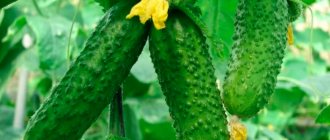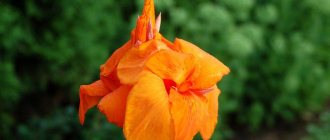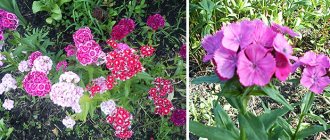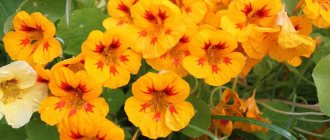Canna is an ornamental perennial that belongs to the family Cannaceae. The first flowers were exported from India, China, South and Central America. It was brought to the European continent by Portuguese ships in the 16th century. The ancient Greek designation can be translated as “reed”, the Latin - “pipe”. An ancient Indian legend tells that the leader of one of the tribes decided to burn the peace treaty in a fire, and a bloody massacre broke out. At the site of the fire, flowers with bloody petals grew, reminiscent of flashes of flame or spilled blood.
Description of the canna flower
The branched rhizomes of the perennial plant spread widely to the sides. Thickened hollow stems from 0.6 to 3 m end in a peduncle. Large leaves in the form of an ellipse or elongated shape have a length from 25 to 80 cm, a width from 10 to 30 cm at the top, sharp, with a smooth surface. The inflorescences and foliage are decorative. The green mass comes in attractive colors, ranging from malachite, maroon, red-brown to lilac.
The inflorescences of the plant, collected in a panicle or brush, are distinguished by a variety of colors. Bloody, golden, soft pink, amber, speckled, bordered, asymmetrical, they resemble a gladiolus or an orchid. Upon fertilization, a three-locular capsule appears.
Canna diseases and pests
Canna has earned great respect among gardeners for its colossal resistance to aggressive environments. However, for the purpose of prevention, gentle treatment is carried out.
Fungal diseases are considered a threat to cannas.
These include the following:
- Gray rot. Botrytis fungus is formed in conditions of high humidity and coolness. The first thing that will indicate a lesion is gray spots on the foliage and trunks. The danger of this disease is that it easily spreads to nearby plants.
- "Rusty" mushroom. Forms when humidity increases. At the initial stage of development of the disease, the leaves become covered with brown spots, and later the fungus accelerates their early fall.
Plants damaged by fungal disease cannot be saved, so they are immediately destroyed.
For prevention purposes, in the fall they carry out:
- treatment with drugs;
- complete digging of the site;
- thorough cleaning of the area.
Viral infections can also be a source of canna disease.
These include:
- Variegation. The lesion is easily identified by the presence of black spots on the leaves. Usually the disease is not dangerous; the growing season simply slows down. In case of severe damage, the inflorescences of the plants curl, decreasing in volume. Treatment consists of removing the affected parts.
- Cucumber mosaic virus. The carrier of the disease is aphids. Leaves are mainly affected. Zonal chloroticity is observed, mosaicism can also be observed, leaf wrinkling and curvature can be observed. To avoid mass infection of canna plantings, plants are constantly examined, removing infected specimens. Preventive measures include exterminating weeds and washing off aphids with water.
A sign of viral diseases are sharply yellowed canna leaves. There are insects that can harm plants.
The main ones are:
- Spider mite. It feeds on the sap of the plant. Favorable conditions for the spread of the pest are dry air. To reduce reproduction, it is recommended to increase the humidity of the environment by constantly spraying the plants.
- Shield. A dangerous pest that can destroy a flower. It lives on the back side of the foliage and at the junction of the shoot and the stem. An effective way to combat scale insects is to collect the insect from the plant with your own hands.
- Aphid. A pest that lives on young stems. It feeds on the juice of the flower. Harmful to the development and growth of bushes. It is recommended to combat shoot aphids by treating with a soap solution.
- Slugs. Shellfish eating plants. Loosening the soil and regular inspection for the presence of insects can reduce the risk of their occurrence. Also used to prevent slugs is mulching the soil under the bushes with cones or sawdust.
- Nematodes. Small worms that live off the roots of a plant. May appear when using organic fertilizers in combination with high soil moisture. Due to disturbances in the root system, flowers lack moisture and nutrition. As a result, the development of the bush slows down and deformation appears. You can save yourself from nematodes by treating the soil with insecticides.
Fungal disease
Shoot aphid
Leaf infection with cucumber mosaic
Varieties of cannas
Almost all modern varieties are descended from the Indian species of canna. The cultivated descendants are given the botanical designation Canna hortum.
| View | general description | Height, m | Varieties |
| Crozy | Appeared in 1861. The leaves are malachite or dark burgundy with white. The petals are bent. | 0,6-1,6 |
|
| Orchids | Flowers up to 12.5-17.5 cm in diameter, edges in the form of folds. Dark green or lilac-green tone of leaves. | 1-2 |
|
| Deciduous (Small-flowered) | The leaf is malachite, lilac or green-green in color. The flowers are small, up to 6 cm in diameter. | 3 | Durban: Orange-yellow flowers, striped green leaves. |
Brief description of cultivation
- Landing . Seeds are sown for seedlings in February, tubers are planted in mid-May, and sprouted tubers are planted from the first days of March.
- Bloom . It starts in July and continues until frost.
- Illumination. Needs a lot of light.
- Soil . The soil should be nutritious, rich in organic matter, well drained and warm.
- Watering . It is necessary to water moderately, but systematically. However, during the flowering period it should be abundant.
- Fertilizer . You need to feed twice or three times during the season; for this, mineral fertilizers are used.
- Reproduction . Seed method and rhizome division.
- Harmful insects . Nematodes, butterfly caterpillars, scale insects, spider mites, aphids, slugs.
- Diseases . Rust, gray rot, variegation, cucumber mosaic virus.
Growing canna in the garden
The flowers are unpretentious and can be successfully grown in the garden and in public places. Reproduction is carried out by dividing the tubers and by sowing seeds.
Crozy
Sowing canna seeds
Typically, plants were cultivated using this method for breeding purposes. Canna seeds of easily germinating varieties for garden plots appeared quite recently, but quickly gained popularity.
Seeds begin to germinate in late January-early February. The durable shell does not allow the flower to germinate quickly.
To speed up the process, they help it collapse. It is recommended to use one of the methods:
- treated with boiling water;
- keep for 3-4 hours in a thermos with hot water;
- bury it in a snowdrift for 2-3 hours or put it on the freezer shelf for 1 hour;
- act mechanically.
After this treatment, the seeds are placed in an aqueous solution of a growth stimulator for 24 hours. The prepared seeds are placed in bowls with planting soil to a depth of 0.7-1 cm, after watering they are covered with film and removed for germination, which lasts for a month. At this time, conditions are created in the soil so that its temperature remains at +22 ºC. After 3-4 leaves grow, the seedlings are transferred to separate containers. Flowers develop in them before being transplanted outside. After 3-4 days, the picked seedlings are kept in a room with a temperature of +16...+18 ºC.
Growing from rhizomes
Dividing the rhizome is a reliable way to propagate cannas. It begins in the last ten days of March - the first days of April. The roots, stored in the cellar over the winter, are cleaned and the dried parts are separated. Each is cut into sections, focusing on the number of buds on the tuber. Those who are close do not share.
To prevent infection by fungal diseases, the resulting sections are treated with potassium permanganate (0.2 g per 1 liter of water) or wood ash.
The prepared cuttings are planted in the ground, consisting of equal parts of soil, peat chips and rotted manure. You shouldn't go deep. Germination of the first leaves should be expected in 2-3 weeks. As they appear, the pots are moved to well-lit rooms, where they will be at a temperature of +16...+18 ºC. Under the created conditions, new shoots do not stretch and develop in time. Minor watering and keeping the temperature down is all the care young seedlings need.
Cannas from seeds
I never thought that cannas could be grown from seeds. No, well, it’s clear that probably everything can be grown from seeds. Seeing these seeds, I became very interested, can I do it? So I bought some seeds for myself in the hope of something good and beautiful
And here are its seeds:
In order for the seeds to germinate better and faster, they had to be damaged somehow... Or rather, damage the shell, since it is very hard. After reading various tips, I decided to do this - pour boiling water over it for 10-15 seconds. I poured them in, heard a cracking sound and took them out of the boiling water and put them in cups with soil. I ran around looking almost every hour, what was it and how was it))))) On the tenth day - it was March 1st, I saw this sprout
To say that I was joyful is to say nothing! I was jumping for joy! After all, I did it. And on the 11th day I got 3 more sprouts in another glass
I really can't put into words what happened to me! So much joy, wow! I was waiting for the fifth, but still nothing... In the online store where I usually order seeds, I read reviews, almost everyone there writes that 5 seeds produce 4 sprouts, and some get none at all... But for me I’m lucky, I also have 4 of them. We are growing by leaps and bounds. Today is March 6, 2015, and we are already like this
This is the gift I received on the first day of spring! Since this is a mixture of seeds, it’s very interesting what kind of colors I got there?! I bought another pack of these seeds and will sow more today. I need to plant 3 sprouts in different cups, but I’m somehow afraid to climb there, I’m scared if I damage something, but there’s nothing to do, so I’ll do it today. So, dear amateur gardeners, flower growers and just gardeners, you can sow CANNA from seeds and not wait for the expensive tubers to start selling. It is clear that if you buy a tuber, you can get a flower in the first year, but this is also not a fact. Taking into account the rapid growth, I hope for flowering this year))))) I wish everyone good luck and fertility!
When to plant cannas
Cannas are transferred to open ground after the end of return frosts. Damaged roots can take a long time to germinate, development lags behind, delaying flowering, and possibly its complete absence.
Deciduous
Soil selection
Planting flowers requires a sunny place, protected from drafts and wind. Canna loves humus-enriched, warm soils. The garden space is prepared in advance. To do this, dig a hole with a diameter of 0.5-0.6 m. The bottom is filled with fresh manure 0.2 m high. Due to it, the rhizome will become warmer, the flower will actively develop and bloom well. Soil is poured on top of the manure. The rhizome is placed in the spilled hole, with the growth point facing upward, and sprinkled with earth. The planting depth of unsprouted rhizomes is no more than 6-9 cm. A distance of 0.5 m is maintained between plants, and 0.3 m between dwarf varieties. The same is maintained between rows in the case of a large number of seedlings. Mulching the planted flowers allows you to protect the plantings from lack of moisture and weed germination. After planting, it takes 2 weeks for sprouts to appear; 1.5-2 months pass before flowering. At temperatures below +15 ºC, the emergence of seedlings is delayed.
Then the flowers require timely watering, loosening of the top layers of soil and fertilizing.
When to plant canna flower seeds for seedlings in the spring?
The seeds of these flowers are planted for seedlings at the end of February. To do this, prepare a light substrate and place containers with seeds in a shaded place at a temperature of 23 degrees. With proper planting of seeds, seedlings can emerge in 25-27 days.
When the seedlings have 4 true leaves, the seedlings need to be planted in separate pots and placed where the temperature does not rise above 16 degrees. This way you can start preparing future flowers for open ground.
With this method of planting cannas, some flowers can form beautiful and bright inflorescences this year. But, most often, flowering occurs only the next year.
How to fertilize cannas
Throughout the growing period, cannas are given additional feeding for timely development. Along with watering, add 2 g of potassium permanganate to a bucket of water (or place granules under each plant). This stimulates the start of flowering. Before flowering, nutrition is applied in the form of a solution of chicken manure and water in a ratio of 1:10. A similar watering is repeated after 2 weeks. Cannas love complex mineral fertilizers sprinkled under each bush. They are mixed with the soil at the time of loosening.
When watering, you need to monitor the amount of water. Excess may create the possibility of an outbreak of fungal diseases.
At the end of the season, the root collars are sprinkled with soil to avoid damage with the onset of cold weather. During the first frosts, pruning is done by 15-20 cm. Digging at the end of September is carried out with a large lump of soil.
Landing dates
The time from the awakening of the Canna bulb to the formation of an independent flower, ready for planting in open ground, takes from one and a half months. Therefore, it is possible to independently calculate the onset of the flowering period. According to the general recommendations of gardeners, bulb germination should begin at the end of March.
For the canna flower, planting and care in open ground begin in early spring. With the retreat of spring frosts, you can begin to prepare the place. Traditionally, planting in the ground can be done in early May. Due to the soft sunlight, this time of year is considered the most favorable for the growth of all plants in open ground.
Taking into account the late onset of spring in some regions of the country, planting in May is impossible due to climatic conditions. Here you need to focus on the established ambient temperature. Positive temperatures from 15°C to 20°C are suitable for rapid and comfortable growth of cannabs. In the middle zones it is better to plant sprouted cannas in the second half of May, and in the northern regions - in early June.
Storing canna in winter
At the end of August, the cannas are transplanted into containers, which can be easily brought indoors if there is a threat of frost. The final digging is carried out in the last days of September or the first days of October; the flowers are not frost-resistant. To improve the wintering of cannes, it is important to create an air temperature of +7…+15 ºC. She has no noticeable rest period.
The plant pleases the gardener with its beauty all year round. However, in order for the flowers to enter the blooming stage, it needs to create conditions. For 2 months, cannas are stored in a cool place with little lighting, while reducing watering. After digging, storage is carried out in perlite, sphagnum moss or peat, poured into plastic boxes, at a temperature of +6...+8 ºC. They try to avoid touching the tubers. Twice a month the condition of the rhizomes is checked, if necessary, wetting the materials with which they are covered with water. The damage is removed and the cut area is treated with iodine.
Preparing seeds for sowing
The seeds have a very hard shell and to obtain seedlings it is important that the shell clears the way for the tender sprout in time. The following activities contribute to this:
- stratification;
- soak;
- scarification;
- warming up.
1.5-2 months before sowing, the seeds are removed from storage, calibrated by size, and mixed with moistened river sand. For 1 part of seeds, 3-4 parts of sand are placed in a container and placed in the vegetable compartment of the refrigerator for cooling (stratification).
Around mid-February it is time to sow Cannes. The seeds are removed from the refrigerator and soaked in water at room temperature for 12-18 hours. If the hard seed coat has softened a little, it is lightly cut with a sharp knife or scalpel, being careful not to damage the embryo. If the shell remains hard, then the seeds can be wrapped in a damp cloth and placed near heating devices for 20-24 hours to warm up, and then scarification can be repeated.
Sometimes they resort to scalding the seeds with boiling water for 1-2 seconds. In this case, the crackling sound of the opening seed coats may be heard. However, such an operation can harm the embryos and must be carried out very quickly.
Canna at home
Cannas are grown independently or transplanted in the fall from a flower garden into a flowerpot with a diameter of at least 50 cm. To avoid infection of domestic plants, the ground is treated with insecticides in advance. In winter, the flower becomes a bright corner that attracts the eye. To thrive, it requires a lighted place and timely watering. The leaves of the plant are gently wiped several times. After flowering it needs rest. Cut the stem to a height of 10-15 cm and put it in a shady place with a temperature of +10 ºC.
Reproduction
Propagating cannas will not be difficult - it is enough to have at least one copy of the plant in the garden. Subsequently, seeds can be collected from an adult flower, and also propagated in the new planting season by dividing the rhizome. After crushing, independent plants are formed. Both options are ideal for propagation at home.
Usually, during the summer period, a young canna gains strength and grows a root; later, new bushes can be obtained from it. The division of the root is carried out in the spring, almost before planting. It is sent for storage intact, but sometimes damage or breaks occur. In such cases, it is worth treating the wounds with charcoal or activated carbon, this will help preserve the rhizome from rotting. When the new planting season begins, the bulbs are still dormant and can more easily tolerate division.
Reproduction is carried out according to the instructions:
- The root is freed from the earthen coma, dry and bad areas are removed.
- Disinfect by washing in a manganese solution.
- Using a thin garden knife, the rhizome is divided into separate pieces, so that each has living buds. It’s worth keeping more than two eyes on each one. This will give more strength to survival and development.
- Sanitary processing of sections should be carried out immediately after the procedure. Ready-made disinfectant formulations are suitable for this purpose.
The method of propagating cannas by seeds is very simple to implement. You just need to collect them when the seeds ripen and plant them next year. The advantage of this method is that you will get a completely new plant, with its own unique properties, the disadvantage is that the planting material must be used next spring. Canna seeds lose their germination properties over time.
Problems when growing cannas
The flower plant is susceptible to diseases and various types of pests.
| Disease/pest | Symptoms | Corrective measures |
| Viral diseases | Yellow stripes develop along the veins and on the leaf. Then faded spots appear, plant development is delayed, and flowering is delayed. | There is no cure. Plants should be dug up and destroyed. |
| Fungal diseases: rust and gray mold | Orange spots all over the plant. Brown spots on the flower. | Adjust the humidity of the soil and surrounding air. Increase circulation. Adjust temperature. Spray the leaves: ¼ teaspoon of chlorothalonil per 1 liter of water. Repeat the procedure after 10 days. |
| Phytoplasma disease | The leaves turn yellow, wrinkle, and grow deformed. | Destroy the diseased plant. |
| Leaf rollers | The appearance of holes in leaves eaten by insects | Set traps or collect by hand. |
| Spider mite | Yellow thickenings on the leaves. | Treat with horticultural oil, insecticidal soap or solution. Periodically pick off the old lower leaves. Reduce watering and nitrogen fertilization. |
| Thrips | Clear or yellow spots. |
How to care for cannas outdoors
Caring for cannas is no different than what you usually do when caring for other flowers in your garden.
- Timely watering, especially if the weather is dry and hot (at least once every 7-10 days). In this case, it is better to drink generously, but not often.
Have you seen what kind of foliage the canna has? It is obvious that the plant loves water. And sprinkling.
- Regular loosening and weeding.
Advice! Mulching is a real benefit not only for plants, but also for gardeners. You need to water less often (mulch will not allow moisture to evaporate quickly), the need for loosening and weeding, as a rule, disappears altogether.
- If you have filled the soil where the cannas grow with a sufficiently fertile substrate, then you can do without fertilizing. But, if you want the plants to be powerful and bloom profusely, then you can feed the cannas a couple of times with any complex fertilizer for flowering plants (more potassium and phosphorus, a little nitrogen), the same Fertika, Agricola, or, in extreme cases, nitroammophos.
If you want to get involved, then first it is better to give nitrogen fertilizer (to increase green mass), and then potassium-phosphorus (more potassium) for lush and long-lasting flowering.
- Do not let the seed pods set if you are not going to grow cannas from seeds (and this is a very tedious undertaking), because The plant spends a lot of energy on seed ripening.
Advice! Remove faded inflorescences along with flower stalks , then new ones will grow in their place.
Mr. Summer Resident recommends: canna in the landscape
Cannas are good both in group plantings and planted individually, which is why they are loved by landscape designers. It is good to plant against the background of low-growing plants: marigolds, coleus, cineraria. Combine with kochia, perilla and petunia.
Orchids
When planting with other flowers, provide a central position by placing medium-sized and low flowers around. When planted in groups, they are placed in the form of wide and long ridges.
Summer balconies, loggias and terraces are decorated with flowers, planted in a flowerpot or large tub.
Photo gallery
Grown canna seedlings
Seed pod
Canna in landscape design
Storing canna rhizomes for storage in the cellar
Where can you buy cannes?
There are many options for purchasing canna planting material for breeding them in the garden:
- From February or March, specialized stores begin selling bulbous and rhizomatous flowers.
- A wide variety of varieties and sales options are offered by online stores.
- You can agree with your neighbor in your dacha or plot to buy the variety you like or offer him a profitable exchange.
- You can also buy canna roots or seedlings at the market, if you are sure that the seller is respectable.
In any case, it is worth having these beautiful plants in your flower beds, because not every flower can boast such a long flowering period. And cannas, with appropriate simple care, are able to delight the eye with their cheerful, playful and at the same time exquisite flowers from early summer to mid-autumn.
Methods for germinating canna
There are two ways to grow canna - seed and from rhizomes. Both methods are quite effective. Only when growing with seeds you will have to be patient; this method is not quick.
How to grow canna from seeds
The main disadvantage of this method of canna breeding is that young plants do not retain the varietal characteristics of their parent flowers. Also, seeds may not appear on all varieties, but on some in small quantities and very late after flowering.
For planting, you need to use only those seeds that are fully ripe. If plants are grown outside, they bloom until autumn. You need to seize the moment and collect planting material when it is already ripe, but do this before the onset of frost.
Before sowing seeds, they need to be prepared. The seed shell is thick, because of this the emergence of seedlings may be delayed or may not occur at all. Before planting, you can rub it with sandpaper.
You can plant seeds in late February - early March.
- Drainage is poured into the bottom of the container, and then soil is placed.
- Make small holes in the soil and plant the seeds.
- Lightly sprinkle with soil.
At the end of planting, water generously with warm water. Planting material can be planted either in individual peat pots or in a common container. After the seeds hatch and grow a little, they need to be picked. If the seeds were planted in different containers at once, this step can be skipped.
For picking, it is better to use peat cups and, together with them, plant the bush in a pot in a permanent place. The seedlings are carefully removed. The main thing is not to damage the root system, which has just begun to form. The seedlings need to be planted together with the lump of soil in which they grew before.
How to germinate from rhizomes
The easiest way to grow cannas is from rhizomes. When propagated by this method, unlike seed propagation, varietal characteristics are preserved. Spring is best for growing this way.
The process of growing a flower from a rhizome:
- Dig up the bush and carefully divide the rhizome.
- For cuts, use a sharp knife, which is pre-disinfected.
- The cut areas are treated with antifungal agents: dusted with wood ash or treated with a solution of potassium permanganate.
- For planting, use soil containing peat, turf and sand in equal quantities.
- You can also use wet sawdust instead of soil.
- It is necessary to plant so that the rhizome is not too deep.
- At the end of planting, lightly sprinkle the rhizome with soil or sawdust.
Water the soil with warm water. It is also good if you add a little potassium permanganate to the water.
Care: the main thing is not to let it dry out
Further caring for your canna will not be difficult for you. Don’t forget to water these beautiful creatures regularly, once or twice a week, and after watering, loosen the soil and remove weeds.
To retain moisture in the soil and also prevent the proliferation of weeds, you can mulch the soil around the cannas with sawdust or organic material. From the end of August we begin a gradual reduction in watering for normal ripening of rhizomes.
Independent collection of deutia seeds and their selection for sowing
In Deutia species, which bloom annually and are capable of bearing fruit even in the middle zone, the seeds are usually collected in October. After drying, they are removed from the fruit and must be kept in a hermetically sealed container or, if possible, a vacuum bag. Seeds do not lose their viability for up to 3 years under ideal storage conditions (shade, coolness, sealed packaging), but under any storage conditions you can be sure of the high germination of seeds collected last year.
When buying deutia seeds, you should choose trusted manufacturers who, in addition to this shrub, include other beautiful flowering species in their catalogs
Pay attention to the full species name and compliance of the described characteristics of the shrub, including height, with standard parameters. Do not buy seeds that have been stored longer than 1 year from the date of production (packaging)
Reasons for popularity or why cannes are so in demand
Cannas can be planted individually or added to a flower arrangement. When choosing which flowers will be the best and undemanding decoration for a flower garden, be sure to take a closer look at cannas. It’s not for nothing that they are the favorites of designers when decorating city flower beds; they are planted as a separate plant or as part of compositions. There are several reasons for these magnificent flowers to show off on your site: The plants are undemanding and do not require special care. They practically don't get sick. They are not afraid of pests.
They can easily tolerate short-term drops in temperature. They are drought-resistant plants. The flower amazes with the beauty of the inflorescence. Its beautiful large shape will definitely become the center of attention of the flower bed and flower garden. Canna has a long flowering period: about two months it will delight with large flowers beautifully collected in inflorescences. A flower decorates a flowerbed not only due to its inflorescences. Currently, there are plants with beautiful decorative leaf shapes that look great in the garden. The plant itself is distinguished by a thick, fleshy stem up to 2 m high. The straight shape fits beautifully into the floral ensemble. And the strong stem can withstand wind loads.











